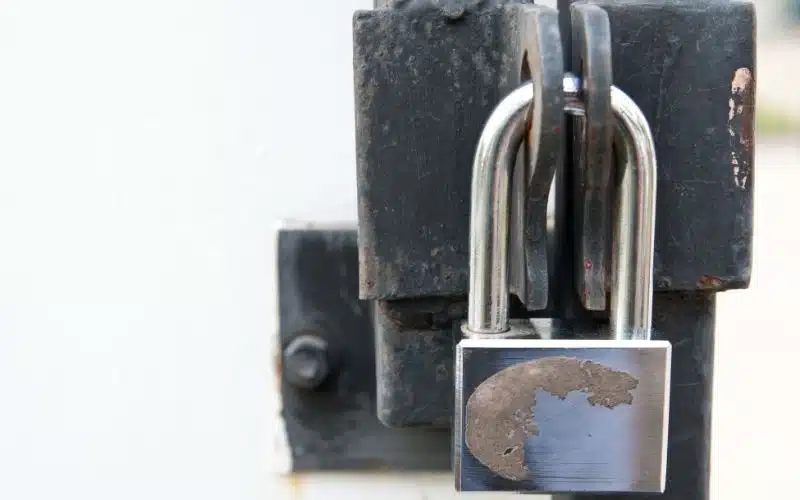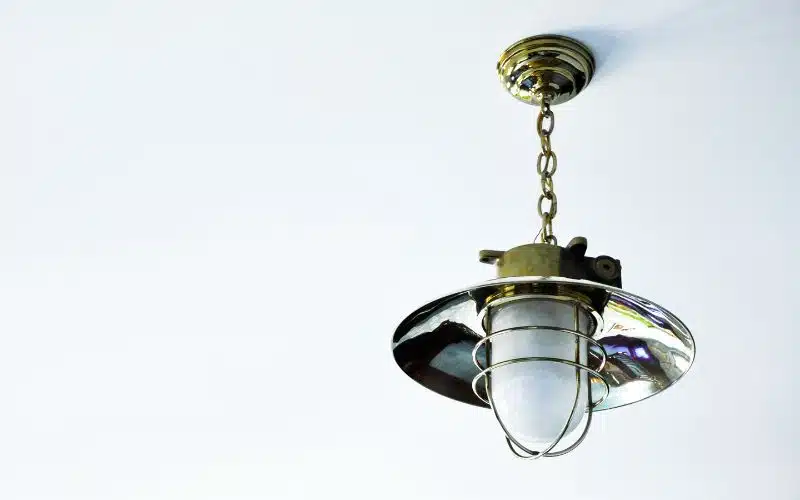The backyard gate is the most critical security post on your property. It is an entry point for wild and wandering animals, and it also takes first place on a burglar’s housebreaking strategy list.
Any investment you make into securing your backyard gate, either in cash or in gaining awareness of the best locking practices, is well worth the price.
You can lock your backyard gate. Many factors come into play in securely locking your backyard gate, from the material and type of gate latch you use to the hidden tips burglars use to jack a backyard gate open. Your learning and implementing these factors make your backyard gate into the fortress it should be.
Can You Put a Lock on a Fence Gate?

We’ll discuss later that you can and should consider putting a lock on your fence gate.
As opposed to the general notion that installing a lock on your fence gate must come with breaking your sweat or paying someone to help you with it, you can install the lock yourself.
With a little guidance on it, you’d be good to go.
You can place different latches on your fence gate depending on the extent of security you need and your budget.
These locks differ in their functional design and material; nonetheless, your lock material should fit that of your existing fence, if there’s one).
Thus, it’s best to properly understand how each works before zeroing in on any particular one.
The Types of Vinyl Fence Gate Locks
#1. Gravity Gate Latches
Gravity-operated locks are the perfect option for DIY because you can easily install them yourself.
In addition, they are self-latching, working almost independently because of the gravity-oriented design.
The latch leverages the force the fence gate swings with, either by human involvement or the wind, to push the latch arm, pass the strike plate, and let the arm fall into the catch.
Although a gravity gate latch is independently reliable, it gives more security with an extra, differently-designed lock — such as a sliding bolt lock.
They always come as a two-sided design, allowing easy access from either side of the gate. The lock also always has holes to let you use a padlock.
#2. Bolt Gate Latches
Bolts are the traditional picture most people have about locks. They work by a simple mechanism of a rod sliding into a securing slot that holds it down and ensures a firm closure.
It’s the perfect option for those who don’t need anything complicated and those on a budget, as it comes in different sizes and material quality.
It may be designed to align with both in-swinging and out-swinging fences and use a padlock.
Unfortunately, bolts are usually one-sided, so you can only access them from one side of the fence gate.
#3. Spring-loaded Gate Latches
This model uses a spring to ensure a quick and secure fence gate fastening. Due to its complex design and machine-like action, they can guarantee a more seamless operation.
Unlike the gravity gate latch, this latch isn’t self-closing but needs you to put some pressure on the latch arm, which snaps into place through the embedded spring.
Its similarity to gravity latches is that it’s also mainly designed for in-swinging gates.
#4. Thumb Fence Latches
Thumb latches can be accessed from both sides of the fence gate and are mainly used in-swinging fences.
The thumb latch works by a thumb depressor and is usually placed on a decorative plate.
The gate opens by lifting the latch arm and pressing the depressor arm with your thumb.
If you installed the latch arm correctly, the gate should self-latch as you take off your thumb from the depressor.
#5. Fingertip Release Fence Latches
The fingertip design gives you a simple answer to fence gate security, just as its name implies. It works for vinyl fences and other types of fences and is affordable.
Should I Lock My Backyard Gate?
Definitely, yes. Your security was the whole reason you installed a fence and gate in the first place, and it won’t be complete until you make it a habit always to lock your backyard gate.
Amongst a plethora of reasons, here are a few you probably already know and can never forget:
#1. Thieves
If thieves would take the extra effort to jump a fence or rob a home with arms, you can be sure they won’t sleep on the opportunity of an open backyard gate.
InterNACHI (International Association of Certified Home Inspectors) shows that 22% of burglars break in through the back door.
The reason is that often, backdoors are less secure than front doors. Therefore, the more secured your backyard gate lock is, the lesser it is an option for thieves.
#2. Pets
Dogs, Cats, Horses, or any other pet would permanently cease a chance to take a stroll out of their confinement zone, whether with your consent.
And you can’t be sure they know the way back home. So, it’s essential always to safeguard your backyard gate if you have them around you.
#3. Pool
Safety regulations mandate that your compound is under lock and key if you have a pool in the yard.
You could be held liable if anyone wandered in and thought to get some enjoyment out of your pool but injured himself.
How Do You Secure a Yard Gate?
You secure your yard gate by installing a fence gate latch on it. As discussed earlier, gate locks vary in their complexity, and some might require professional hands to install.
However, if your preferred lock is a simple type — like the sliding bolt gate lock — you won’t need an extra hand.
With these simple steps, you can install a lock-in in hours.
#1. Get the Needed Materials
The first step to installing your gate lock is to create a list of tools and materials you would need and get them ready to prevent pauses during the installation process.
This preparation would also mean charging your drill fully and getting a smaller drill than the lock’s screw.
#2. Mark Out the Screw Placement Points
Place the two latch pieces in the exact spots you’d love them to be when the installation is over.
Ensure that both are evenly placed in the lock position and mark out where each screw will go with a pen on the post and the gate door.
If it’s a doubly-flanked gate, they’ll be on both flanks. But if it’s a single gate, they’ll be on the gate and on the post to which it’ll be attached.
#3. Drill Holes For the Screws
This step would require proper protection with safety glasses to prevent wood splinters from entering your eyes. With this done, use the drilling bit to make holes in the previously marked points.
These holes should align perfectly with the marks to ensure they don’t shift away from the screw center when placing the latch.
Consider providing the bit has a slightly thinner width than the screw; it makes the screw fit in tightly.
#4. Screw-in the Lock
Separately screw in the two latch pieces into their prepared spots.
For each one, align the screw hole with the hole on the latch, place the screw through both holes, and screw it in with a screwdriver. It should give a firm fit if you were good with the last step.
#5. Do the final checks
Before sitting to rest, prove your work’s success by flipping the door’s latch over the post and seeing if it fits. Also, try adding a padlock to it.
If these work seamlessly, then your work is completed. But if not, you might need to take off the latch and give it another try.
How Can I Make My Back Gate More Secure?
It’s essential to do everything needed to secure your back gate. The following tips will help you get the best out of your back gate:
#1. Use Double Pad Bolt
Most gates come with a pad bolt, cutting the cost of getting one yourself. But adding an extra pad bolt guarantees you more security because you’d place one on top and the second below.
This method prevents thieves from quickly pushing the door open or leaning over the gate to unlock the top bolt and get in.
#2. Use a Long Throw gate Lock
The Long Throw gate lock is a gate latch lock that you can place on one or both sides of the gate and unlock with a key. It has a stainless steel bar and provides good security.
The ideal choice is a combination of the padlock and the long throw gate lock.
#3. Place Hinges Inside the Gate
Unless there’s a reason to leave them outside, ensure the hinges are protected inside the gate to prevent thieves from efficiently removing them.
What Can I Put On My Fence To Stop Burglars?
Your first option is to install a light timber trellis wrapped with very thorny plants to your fence’s top. The mere sight of this discourages any intending thief.
Another option is to fix the solid commercial fence spikes.
Although fence spikes might be pretty expensive, they are hard to remove or maneuver.
Barbed wires and razor tapes also do a good job but might not meet your aesthetic taste if that’s a factor you’re considering.
Summary
No effort put into adequately locking your backyard gate is wasted; because your security and your loved ones and property are paramount.
It might mean using the appropriate gate and lock combination, installing the lock with professional assistance, or fixing the needed security accessories on your gate.
Whatever the cost might be, it’s well worth it.






